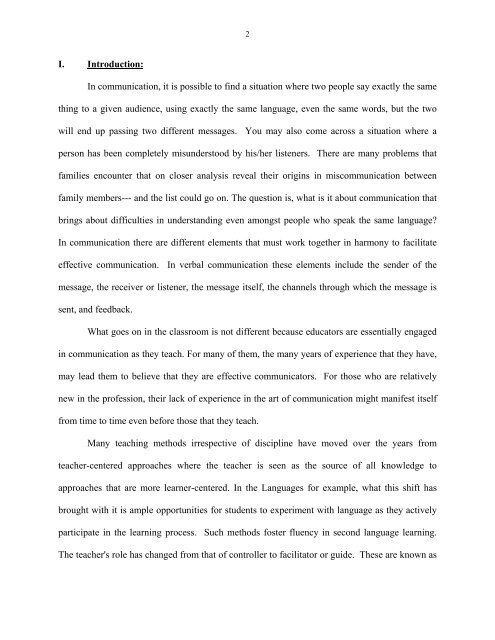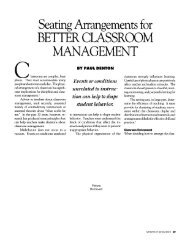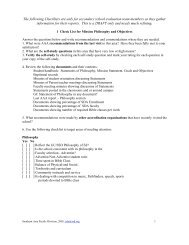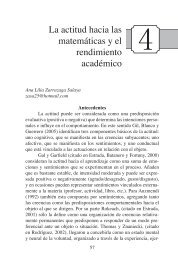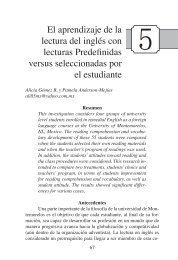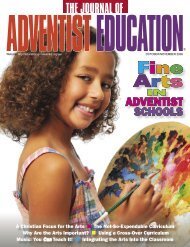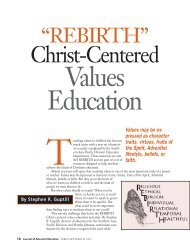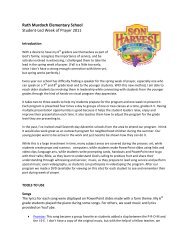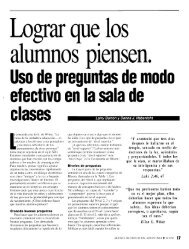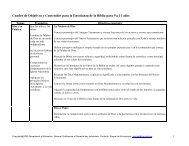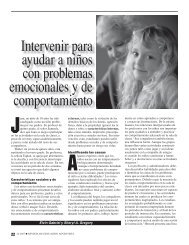Verbal Communication in the Classroom: What Christian ... - Circle
Verbal Communication in the Classroom: What Christian ... - Circle
Verbal Communication in the Classroom: What Christian ... - Circle
You also want an ePaper? Increase the reach of your titles
YUMPU automatically turns print PDFs into web optimized ePapers that Google loves.
2<br />
I. Introduction:<br />
In communication, it is possible to f<strong>in</strong>d a situation where two people say exactly <strong>the</strong> same<br />
th<strong>in</strong>g to a given audience, us<strong>in</strong>g exactly <strong>the</strong> same language, even <strong>the</strong> same words, but <strong>the</strong> two<br />
will end up pass<strong>in</strong>g two different messages. You may also come across a situation where a<br />
person has been completely misunderstood by his/her listeners. There are many problems that<br />
families encounter that on closer analysis reveal <strong>the</strong>ir orig<strong>in</strong>s <strong>in</strong> miscommunication between<br />
family members--- and <strong>the</strong> list could go on. The question is, what is it about communication that<br />
br<strong>in</strong>gs about difficulties <strong>in</strong> understand<strong>in</strong>g even amongst people who speak <strong>the</strong> same language?<br />
In communication <strong>the</strong>re are different elements that must work toge<strong>the</strong>r <strong>in</strong> harmony to facilitate<br />
effective communication. In verbal communication <strong>the</strong>se elements <strong>in</strong>clude <strong>the</strong> sender of <strong>the</strong><br />
message, <strong>the</strong> receiver or listener, <strong>the</strong> message itself, <strong>the</strong> channels through which <strong>the</strong> message is<br />
sent, and feedback.<br />
<strong>What</strong> goes on <strong>in</strong> <strong>the</strong> classroom is not different because educators are essentially engaged<br />
<strong>in</strong> communication as <strong>the</strong>y teach. For many of <strong>the</strong>m, <strong>the</strong> many years of experience that <strong>the</strong>y have,<br />
may lead <strong>the</strong>m to believe that <strong>the</strong>y are effective communicators. For those who are relatively<br />
new <strong>in</strong> <strong>the</strong> profession, <strong>the</strong>ir lack of experience <strong>in</strong> <strong>the</strong> art of communication might manifest itself<br />
from time to time even before those that <strong>the</strong>y teach.<br />
Many teach<strong>in</strong>g methods irrespective of discipl<strong>in</strong>e have moved over <strong>the</strong> years from<br />
teacher-centered approaches where <strong>the</strong> teacher is seen as <strong>the</strong> source of all knowledge to<br />
approaches that are more learner-centered. In <strong>the</strong> Languages for example, what this shift has<br />
brought with it is ample opportunities for students to experiment with language as <strong>the</strong>y actively<br />
participate <strong>in</strong> <strong>the</strong> learn<strong>in</strong>g process. Such methods foster fluency <strong>in</strong> second language learn<strong>in</strong>g.<br />
The teacher's role has changed from that of controller to facilitator or guide. These are known as


